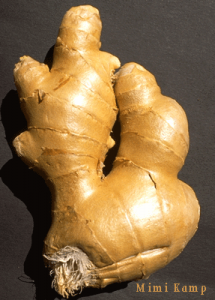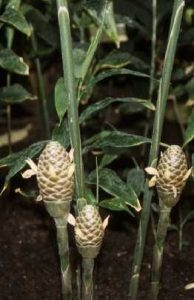Table of Contents
Ginger
(Zingiber officinale)
- Alias names for Ginger: African Ginger, Black Ginger, Race Ginger, Zingiber officinale, Family: Zingiberaceae, Sheng Jian (Chinese), Singabera (Sanskrit)
- Chinese Name for Ginger: Sheng Jian
Pictures of Ginger:
About Ginger: Ginger is a perennial which can grow up to 3 feet tall and has dark glossy green two ranked leaves that surround the base of the stem which may have white or yellow flowers. It grows out of tuberous rhizome roots and prefers moist fertile soil in partially shaded warm climates. Although ginger originated in India and China, the root is now cultivated all over the world as a spice, food alternative, and medicinal herb. The plant can be propagated through rhizome division and then harvested after about 10 months.
References for Ginger pictures:
- https://www.floridata.com/ref/Z/zing_off.cfm
- https://pharm1.pharmazie.uni-greifswald.de/systematik/7_bilder/yamasaki/Zinger.jpg
- https://www.rimbundahan.org/environment/plant_lists/taman_sari/Zingiberofficinale.jpg
- https://home.caregroup.org/clinical/altmed/interactions/Herbs/Zingiber_offici.htm
- www.naturedirect2u.com/…/ginger.htm
Actions and Historical Uses of Ginger:
- Abdominal bloating
- Arteriosclerosis
- Bronchitis
- Chilblains
- Cholesterol
- Circulatory remedy
- Colds
- Colic
- Colitis
- Colon cleanser
- Constipation
- Coughs
- Diarrhea
- Digestive system
- Diverticulosis
- Fever reducer
- Flu
- Food poisoning
- Gas
- Gastrointestinal infections
- Heart disease
- High blood pressure
- Hot flashes
- Immune system
- Indigestion
- Menstrual cramps
- Migraine headaches
- Morning sickness
- Motion sickness
- Nausea
- Raynaud’s disease
- Stomach cramps
- Strokes
- Ulcer prevention
- Vomiting
- Whooping cough
Historical Uses for Ginger and how it Works:
Ginger lessens the ability of blood platelets to aggregate or stick together thus increasing circulation. In the digestive system, the pungent constituents of ginger alleviate nausea and vomiting. The herb tones the intestinal muscles which makes digestive transport easier.
Chinese herb, ginger is used in two different forms. Fresh ginger is given for fever, headaches, and aching muscles. Dried ginger is used for “internal cold,” with symptoms such as cold hands, a weak pulse and a pale complexion.
Antiseptic, used in a trial study in China, 70% of patients with bacillary dysentery who were given ginger made a full recovery. Ginger is used many ways including:
- Ginger Tea
- Ginger Bath/Soak
- Ginger Infusion Tea for nausea
- Ginger Essential oil for arthritic aches
- Ginger Capsules for morning sickness and motion sickness
- Ginger Tincture for digestion
- Ginger Extract
- Fresh Ginger
- Ginger Powder
- Dried Ginger
- Ginger Tablets
- Ginger Ale
- Ginger Soda
- Ginger Snaps
- Sugared Ginger (digestive aid)
Parts of the Ginger plant used:
Rhizome/root/tuber.
Properties of Ginger:
Antiemetic, anti-inflammatory, antiseptic, carminative, circulatory stimulant, inhibits coughing
Chemical Constituents of Ginger:
Bisabolene, gingerol, oleoresin, shogaols, volatile oil, and zingiberene
Contradictions, safety issues, concerns, harmful drug interactions and allergy precautions for Ginger:
Ginger is generally a safe herb to use, however there are some precautions. While short-term use shows no ill effects, long-term use of ginger during pregnancy is not recommended. Sensitivity to the taste may occur as well as development of heartburn. If you have had gallstones you should first seek the advice of a health care professional before using ginger. Pregnant women should not exceed the dose of 1 gram daily. Doctors should be notified of the use of ginger before going into surgery.
Helpful Links and References for Ginger:
- Do Herbs by Sandy Brooks
- Herbal Medicine by Dian Dincin Buchman’s
These products are not drugs, but foods for special dietary use pursuant to applicable Federal law. No statement in this page shall be construed as offering these products for the diagnosis, cure, mitigation, treatment, or prevention of any disease.
Related Pages on this website:
- My Favorite Herbal Books
- How to make a decoction
- How to make infused oils
- How to make infusions
- How to make a poultice
- How to make a tincture
- List of Herbs we carry
- My Favorite Products
- My Recipes (many of which contain Ginger in some form or another!)

